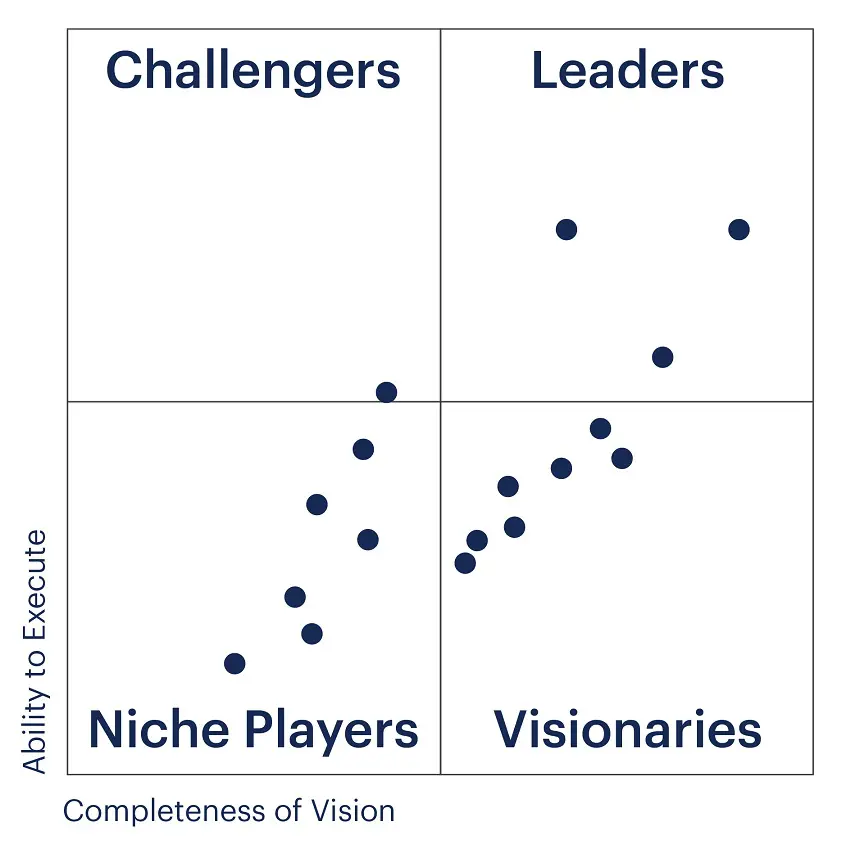The Gartner Magic Quadrant for Digital Commerce is divided into challengers, leaders, niche players and visionaries. Each vendor’s position is assessed on the completeness of their vision and ability to execute it.
The aim is to give customers an impartial view from Gartner’s own experts of comparable digital commerce platforms.
An overview is given for each platform along with the experts’ views on their strengths and weaknesses, called ‘cautions’. The Gartner reviewers are looking for a road map that shows clear commitment to improvement and growth that will support customers’ ambitions for the future.
Digital commerce leaders
To be considered a leader a provider must have wide geographic reach and a comprehensive product offering for multiple industries, meaning there will be plenty of service partners available.
Customers will typically come from a broad spectrum and might include market leaders. Digital commerce leaders are also likely to offer added value through additional complementary products and services.
The standard of digital commerce functionality must be high to meet the needs of large multi-national organizations with integrations, management tools, content management, customization, and options such as progressive web apps (PWAs).
However, in-house expertise or a strong partnership will probably be needed to access the breadth and depth of the available functionality.
Digital commerce challengers
Providers who have the potential to be disruptive for recognized market leaders are likely to be categorized as challengers. Their client base will be smaller but will have potential for rapid growth and expansion.
Plans to extend their international reach will already be developing, although they are unlikely to have a fully global presence. Challengers will be thought leaders who are offering alternative solutions and approaches and high quality digital commerce options for their customers.
They will integrate with a wide range of other providers where in-house solutions aren’t available. This will make challengers an attractive choice for relatively young organizations that want the flexibility to choose ‘best of breed’ solutions for every part of their business. It could mean that they have a wide network of partner extensions.
Compared with leaders, the digital commerce offer from challengers might be more specifically tailored to certain market sectors or requirements. As a result, functionality might be limited in some areas.
Digital commerce niche players
Niche players will be providing high quality solutions across several market sectors and they are likely to offer multiple deployment options. They might be closely aligned with a small number of customers or emerging business sectors, currently operating in a specific geographic area.
Niche players offer in-depth knowledge of their market and comprehensive solutions designed to meet very specific requirements. They are likely to be open to multiple collaborations and partnerships to fully meet their customers’ needs. They will have a clear focus on delivering tailored digital commerce performance.
Due to their specialized services niche players might currently have a smaller number of releases and upgrades. As a result, specialist expertise is likely to be needed to optimize the benefits of working with them. Development into the other quadrants might come from mergers and acquisitions in future.
Digital commerce visionaries
Visionaries might have started out as niche players who are now transferring their expertise to other sectors. Their geographic presence might currently be limited while they expand across multiple vertical markets. Often, they will be meeting very specific requirements through customization and collaboration, making them attractive to customers that value innovation and flexibility. This could mean that the core digital commerce functionality needs further development.
In a crowded marketplace the technical solution will need to be exceptional and closely aligned with customer requirements. Building on these foundations, visionaries will be growing with their clients.
Cloudfy’s quadrant
Cloudfy has been designed from the outset to meet the ecommerce needs of business to business (B2B) organizations, which could suggest it belongs in the niche player quadrant. However, with scalability and ease of use at its core it provides powerful options for all business types and sizes.
As a cost effective software as a service (SaaS) solution and with offices in the UK, USA, Australia, and Asia Pacific regions, use of the platform is expanding worldwide.
Cloudfy can meet the needs of clients across multiple sectors who need to consolidate their business systems through integration, who are looking to re-platform, or who have an advanced strategy for digital transformation and growth.
Cloudfy’s clients range from global distribution companies and technology providers to charities and fashion retailers.

There’s a clear roadmap for development and at least two upgrades each year to keep customers at the forefront of digital commerce best practices. Cloudfy provides out of the box integration for many leading business systems, including SAP, Microsoft Dynamics and Sage and has a growing network of trusted partners. With a powerful application programming interface for customizations to meet specialist requirements Cloudfy delivers innovative and flexible answers to diverse business challenges.
The team at Cloudfy values flexibility, so finding the right box for its unique offer isn’t easy. We certainly feature the flexibility and innovation of visionaries and the ambition to bring about improvement and change of the digital commerce challengers and leaders.






